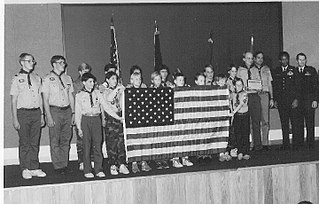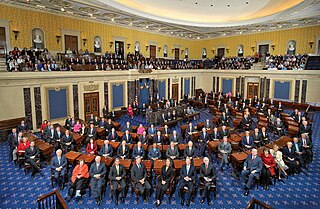Related Research Articles

The national flag of the United States, often referred to as the American flag or the U.S. flag, consists of thirteen equal horizontal stripes of red alternating with white, with a blue rectangle in the canton, referred to as the union and bearing fifty small, white, five-pointed stars arranged in nine offset horizontal rows, where rows of six stars alternate with rows of five stars. The 50 stars on the flag represent the 50 U.S. states, and the 13 stripes represent the thirteen British colonies that declared independence from Great Britain, which they obtained in their victory in the American Revolutionary War.

The United States Capitol, often called The Capitol or the Capitol Building, is the seat of the United States Congress, the legislative branch of the federal government. It is located on Capitol Hill at the eastern end of the National Mall in Washington, D.C. Although no longer at the geographic center of the federal district, the Capitol forms the origin point for the street-numbering system of the district as well as its four quadrants.
United States v. Eichman, 496 U.S. 310 (1990), was a United States Supreme Court case that by a 5–4 decision invalidated a federal law against flag desecration as a violation of free speech under the First Amendment. It was argued together with the case United States v. Haggerty. It built on the opinion handed down in the Court's decision the prior year in Texas v. Johnson (1989), which invalidated on First Amendment grounds a Texas state statute banning flag burning.

The flag of Washington, D.C. consists of three red stars above two red bars on a white background. It is an armorial banner based on the coat of arms granted to Lawrence Washington of Sulgrave Manor Northamptonshire, England, in 1592. This coat of arms was used privately by the president in his home at Mount Vernon. In heraldry, the stars are called mullets and the coat of arms is blazoned as argent two bars gules, in chief three mullets of the second.

Half-mast or half-staff refers to a flag flying below the summit of a ship mast, a pole on land, or a pole on a building. In many countries this is seen as a symbol of respect, mourning, distress, or, in some cases, a salute.

The United States Capitol Police (USCP) is a federal law enforcement agency in the United States with nationwide jurisdiction charged with protecting the United States Congress within the District of Columbia and throughout the United States and its territories. It answers to the Capitol Police Board and is the only full-service federal law enforcement agency appointed by the legislative branch of the federal government of the United States.

A United States Senate page is a high-school age teen serving the United States Senate in Washington, D.C. Pages are nominated by senators, usually from their home state, and perform a variety of tasks, such as delivering messages and legislative documents on the Senate floor and the various Capitol Hill offices. Pages are provided housing and attend a special page school at the Daniel Webster Senate Page Residence. Senate pages were first appointed in 1829. Originally limited to boys only, the Senate page program was expanded in 1971 to include girls. There are a maximum of 30 pages assigned to each Senate session, with 16 appointed by the majority party and 14 by the minority. Pages serve senators of the sponsoring senator's party.
The United States Senate observes a number of traditions, some formal and some informal. Some of the current and former traditions are described below:

The Challenger flag is an American flag that was placed in the flight kit of Space Shuttle Challenger for mission STS-51-L. The flag was sponsored by Boy Scout Troop 514 of Monument, Colorado, whose Scoutmaster was William "Bill" Tolbert, a major in the United States Air Force assigned to the Space Command.

The Ford House Office Building is one of the five office buildings containing U.S. House of Representatives staff in Washington, D.C., on Capitol Hill.

Peace Officers Memorial Day and Police Week is an observance in the United States that pays tribute to the local, state, and federal peace officers who have died, or who have been disabled, in the line of duty. It is celebrated May 15 of each year. The event is sponsored by the National Fraternal Order of Police (FOP) and is implemented by the FOP Memorial Committee.

The National League of Families POW/MIA flag, often referred to as the POW/MIA flag, was adopted in 1972 and consists of the official emblem of the National League of Families of American Prisoners and Missing in Southeast Asia in white on a black background. In 2019 the National POW/MIA Flag Act was signed into law, requiring the POW/MIA flag to be flown on certain federal properties, including the U.S. Capitol Building, on all days the U.S. flag is flown.

The United States Capitol features a dome situated above its rotunda. The dome is 288 feet (88 m) in height and 96 feet (29 m) in diameter. Designed by Thomas U. Walter, the fourth Architect of the Capitol, it was constructed between 1855 and 1866 at a cost of $1,047,291.

In the United States, state funerals are the official funerary rites conducted by the federal government in the nation's capital, Washington, D.C., that are offered to a sitting or former president, a president-elect, high government officials and other civilians who have rendered distinguished service to the nation. Administered by the Military District of Washington (MDW), a command unit of the Joint Force Headquarters National Capital Region, state funerals are greatly influenced by protocol, steeped in tradition, and rich in history. However, the overall planning as well as the decision to hold a state funeral, is largely determined by a president and their family.

The United States Senate is the upper chamber of the United States Congress. The United States Senate and the lower chamber of Congress, the United States House of Representatives, comprise the federal bicameral legislature of the United States. Together, the Senate and the House maintain authority under Article One of the U.S. Constitution to pass or defeat federal legislation. The Senate has exclusive power to confirm U.S. presidential appointments, ratify treaties, exercise advice and consent powers, and try cases of impeachment brought by the House. The Senate and the House provide a check and balance on the powers of the executive and judicial branches of government.

The Daniel Webster Senate Page Residence, also known as Webster Hall, is the residence for United States Senate Pages. The building is a former funeral home and underwent an $8 million refurbishment in 1995, converting it to its current state. It is located near the Hart Senate Office Building, giving pages the ability to walk to and from work. Pages are required to live in the building during the school year. The building has 24/7 protection by the United States Capitol Police both indoors and on foot around the building. The United States Senate Page School is located in the basement of the building. The residential portion of Webster Hall is staffed by adult employees of the United States Senate Page Program, while the school is staffed by employees of the United States Senate Page School. Pages are supervised by proctors, generally graduate students, who are employed by the United States Senate Page Program. $780 per month is deducted from a page's paycheck to fund room and board. In addition to the proctors, there is a program director and an administrative aide. There are two living quarters with one being designated for female students and the other for male students. There are laundry and kitchen facilities in the building. Along with the 24/7 protection by the United States Capitol Police, visitors are required to sign in and all individuals must present some form of identification. During summer sessions pages may request arrangements for alternative housing.

The Silver Star Families of America (SSFOA) is a 501(c) tax exempt organization dedicated to honoring and supporting wounded, ill and injured veterans of all branches of the armed forces of the United States of America. The organization was founded in 2004 by Steve and Diana Newton with the assistance of Joseph and Sharon Newton and the entire Newton family. It is not related to the military decoration designated the Silver Star.
The United States House of Representatives Page Program was a program run by the United States House of Representatives, under the office of the Clerk of the House, in which high school students acted as non-partisan federal employees in the House of Representatives, providing supplemental administrative support to House operations in a variety of capacities in Washington, D.C., at the United States Capitol. The program ended in 2011, although the Senate Page program continued. Pages served within the U.S. House of Representatives for over 180 years.

The United States Senate Chamber is a room in the north wing of the United States Capitol that has served as the legislative chamber of the United States Senate, since January 4, 1859. The Senate first convened in its current meeting place after utilizing Federal Hall, Congress Hall, and the Old Senate Chamber in the Capitol building for the same purpose.

The Congressional Prayer Room near the rotunda in the United States Capitol is a place set aside for the use of members of Congress who seek a quiet place for meditation or prayer. The space is not open to tour groups or visitors to the Capitol.
References
![]() This article incorporates public domain material from Capitol Flag Program. Architect of the Capitol . Retrieved November 4, 2020.
This article incorporates public domain material from Capitol Flag Program. Architect of the Capitol . Retrieved November 4, 2020.